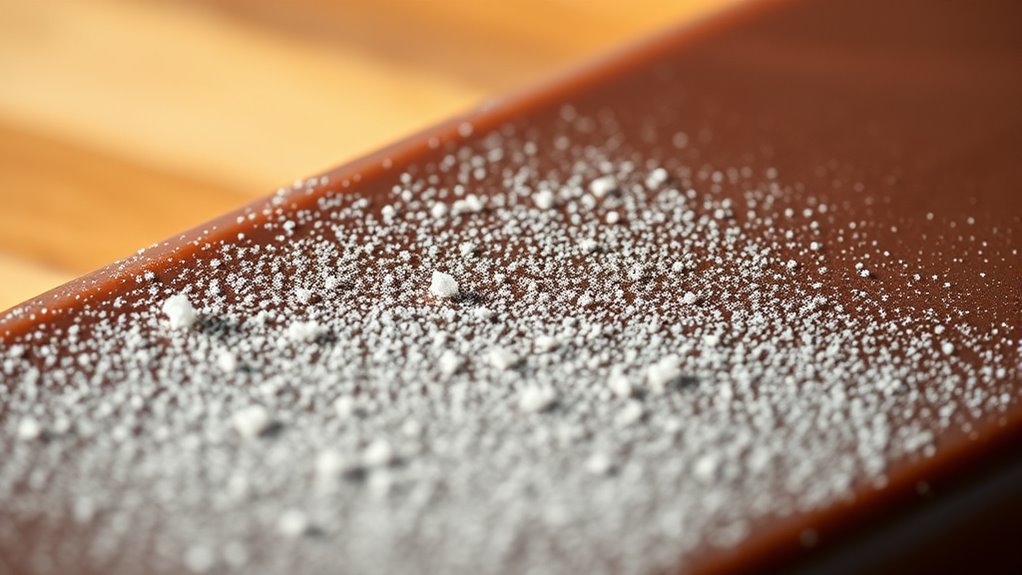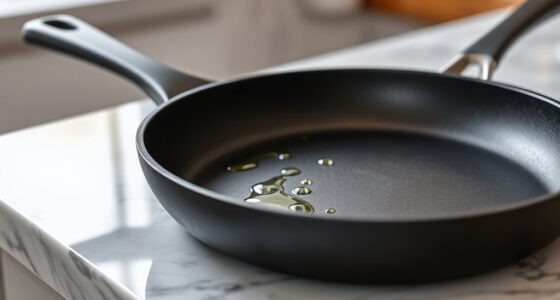Chocolate blooms when fat or sugar crystals rise to the surface, giving it a dull or cloudy look. To prevent this, you need to keep your chocolate properly tempered, which stabilizes the cocoa butter into a shiny, smooth finish. Store it in a cool, dry place away from temperature changes and humidity, avoiding the fridge. Consistent temperatures and proper storage help prevent bloom, and if you keep exploring, you’ll discover even more ways to keep your chocolate perfect.
Key Takeaways
- Chocolate blooms due to fat or sugar crystals migrating to the surface from temperature fluctuations or humidity.
- Proper tempering stabilizes cocoa butter crystals, preventing fat bloom and maintaining a glossy appearance.
- Store chocolate in a cool, dry place at consistent temperatures, away from direct sunlight and humidity.
- Avoid refrigeration, as humidity and condensation can cause sugar bloom on the surface.
- Consistent temperature control and proper storage are essential to prevent both fat and sugar bloom.

Chocolate blooming occurs when fat or sugar crystals rise to the surface, causing a dull, cloudy appearance that can ruin its texture and taste. This common issue often leaves chocolate looking unattractive, with a matte finish and a grainy feel. To prevent this, understanding the role of proper tempering techniques and storage conditions is essential.
Tempering involves carefully heating and cooling chocolate to stabilize its cocoa butter crystals. When done correctly, it results in glossy, smooth chocolate that’s less likely to develop bloom. If you skip tempering or do it improperly, the fat crystals can separate and migrate to the surface over time, leading to bloom. Learning and applying the right tempering techniques is your first line of defense.
Proper tempering creates glossy, smooth chocolate and prevents bloom over time.
You should melt the chocolate to a specific temperature, then cool it to a certain point before gently reheating it to working temperature. This process guarantees the cocoa butter crystallizes into the most stable form, giving your chocolate a shiny appearance and firm texture that resists blooming.
In addition to tempering, proper storage conditions play a vital role in maintaining your chocolate’s quality. Keep your chocolate in a cool, dry place, ideally between 60-70°F (15-21°C), away from direct sunlight or heat sources. High temperatures cause the fat in chocolate to melt and then resolidify unevenly, promoting bloom.
Excess humidity is also problematic because moisture can cause sugar to dissolve and recrystallize on the surface, leading to sugar bloom. To avoid this, store chocolate in airtight containers, preferably with a desiccant packet if your environment is humid.
Consistency in temperature is key; sudden fluctuations can disrupt the crystalline structure of the cocoa butter, increasing the risk of bloom. If you notice bloom on your chocolate, it’s mostly a cosmetic issue rather than a health risk. You can still enjoy it, but the texture might be compromised.
To minimize future bloom, always practice proper tempering techniques and maintain ideal storage conditions. Avoid refrigerating your chocolate, as the humidity when taking it out can cause condensation and sugar bloom. Instead, keep it in a controlled environment, away from temperature swings.
Frequently Asked Questions
Can Blooming Affect the Safety of Consuming Chocolate?
Blooming doesn’t make chocolate unsafe to eat, but it can affect its texture and appearance. You might notice a whitish coating caused by fat or sugar crystallization.
Proper storage conditions, like keeping chocolate in a cool, dry place, and the tempering process help prevent blooming.
While it’s safe, blooming can reduce the chocolate’s quality, so you may want to re-temper or melt it for the best taste and texture.
Does the Type of Chocolate Influence Its Likelihood to Bloom?
You might wonder if the type of chocolate affects blooming. Yes, it does.
Chocolate with higher cocoa content, like dark chocolate, is less prone to bloom because of its stable fat and cocoa solids.
Conversely, milk chocolate, with more milk fats, can be more susceptible due to differences in chocolate processing.
Proper storage and handling help prevent bloom across all types, ensuring your chocolate stays smooth and appealing.
Is Blooming Reversible or Does It Worsen Over Time?
You wonder if blooming is reversible or if it worsens over time. Blooming isn’t fully reversible; it’s a surface issue caused by fat or sugar crystals, and it won’t disappear on its own.
Over time, if you ignore it, the long-term effects can include texture changes and potential flavor impact.
To prevent worsening, store chocolate properly in a cool, dry place, but blooming itself usually stays unless you re-melt and refinish the chocolate.
How Does Humidity Specifically Contribute to Chocolate Bloom?
Isn’t it ironic how humidity effects can turn your glossy chocolate into a dull, unattractive mess? When humidity rises, moisture absorption happens, even through tiny imperfections.
This excess moisture causes sugar or fat to recrystallize, creating that unwanted bloom. So, instead of enhancing your treat, humidity secretly sabotages it, turning your chocolate’s beauty into a dull, dusty surface—proof that too much moisture truly spoils the party.
Are There Commercial Treatments to Fix Bloomed Chocolate?
You might wonder if commercial treatments can fix bloomed chocolate. While some companies offer re-tempering or polishing services to improve appearance, these methods primarily focus on bloom prevention rather than permanent repair.
Keep in mind, bloomed chocolate may still have good quality and taste. To maintain excellent chocolate quality, it’s best to prevent bloom through proper storage and handling, ensuring consistent temperature and humidity levels.
Conclusion
Think of your chocolate like a delicate garden. When stored improperly, it’s like neglecting to water the plants—you might see blooms of sugar or fat on the surface. I once kept a chocolate bar in a warm car, and days later, it looked like a frosted cake. Proper storage is your shield against this. Keep your chocolate in a cool, stable place, and you’ll enjoy its smooth, glossy perfection—like a well-tended garden in full bloom.









